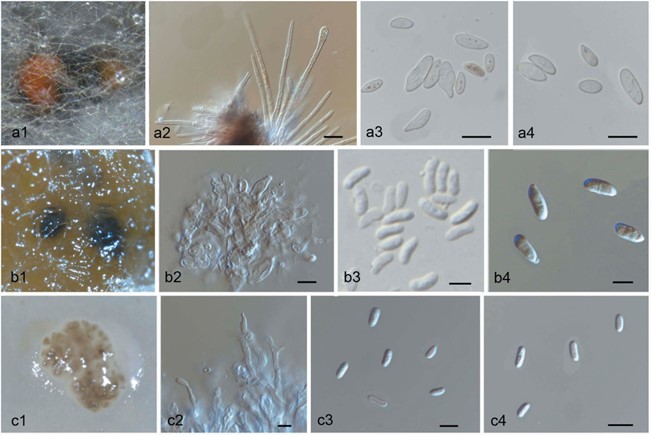Foliocryphiaceae C.M. Tian, N. Jiang & Crous, fam. nov. FIG. 6
MycoBank number: MB 831774; Index Fungorum number: IF 831774; Facesoffungi number: FoF14422;
Etymology: Name derived from its type genus, Foliocryphia.
Type genus: Foliocryphia Cheewangkoon & Crous.
Sexual morph: Ascostromata gregarious or single, semi-immersed, oval to circular from above, comprising two layers, upper layer of yellowish orange to pale brown cells, turning purple in KOH or not, and inner layer of hyaline cells, mixed with plant cells. Perithecia immersed, aggregated, several in one stroma, globose to subglobose, fuscous black to umber, with short necks. Asci 8-spored, unitunicate, cylindrical-fusoid to clavate, pedicellate, with distinct, J- refractive ring. Ascospores overlapping, uniseriate to biseriate, ellipsoid to fusoid, hyaline, smooth-walled.
Asexual morph: Conidiomata multiloculate, subglo-bose to pulvinate; necks short or absent, semi- immersed, orange. Conidiophores cylindrical, asep- tate, hyaline, sometimes reduced to conidiogenous cells. Conidiogenous cells lining inner cavity of con- idiomata, phialidic, ampulliform, inconspicuous, with attenuated or truncate apices, hyaline, smooth. Conidia dimorphic, microconidia minute, cylindrical, aseptate, hyaline to pale brown; macroconidia fusoid, aseptate, hyaline.
Notes: Based on the phylogeny (FIG. 1), Chrysofolia and Foliocryphia, as well as Neocryphonectria, form a well-supported clade (ML/BI = 80/ 0.99) described here as Foliocryphiaceae, which is distinct from Cryphonectriaceae. Genera in this family share some characteristics of Cryphonectriaceae. The orange stromatic tissues of Neocryphonectria turn purple in 3% KOH and yellow in lactic acid, but those of Foliocryphia never change color (Cheewangkoon et al. 2009). Additionally, Chrysofolia and Neocryphonectria have dimorphic conidia (Crous et al. 2015), whereas Cryphonectriaceae only have one conidial type.

Figure 6. Morphology of Foliocryphiaceae species. a. Chrysofolia colombiana (CBS 139909). b. Foliocryphia eucalypti (CBS 124779). c. Foliocryphia eucalyptorum (CBS 142536). a1, b1, c1. Conidiomata formed on OA. a2, b2, c2. Conidiogenous cells with attached conidia. a3, a4, b3, b4, c3, c4. Conidia. Bars: a2–c4 = 5 μm.
Genera
